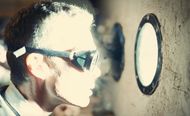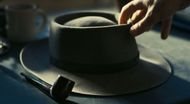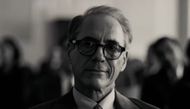Christopher Nolan's Oppenheimer isn't just a marvel with brilliant cinematography and memorable dialogue; it is also filled with many Easter eggs. When most of Nolan's fans were Googling fun facts, such as pictures of Oppenheimer and Einstein, and what he said after the bomb dropped, many history buffs were sitting in front of the screen with their checklist to see how many Easter eggs they could spot.
Nolan, known for his perfection, ensured that he gave the history geeks many Eureka! moments in the film. There are many real-life incidents, political backstabbing, and unknown books that only true historians, Oppenheimer fans, or World War II enthusiasts would know and find in the film.
These hidden gems lend the film a more authentic feel, allowing fans to feel as though they are watching a genuine documentary about the incident. So, if you're an Oppenheimer fan and missed these Easter eggs, then don't worry - this list is for you. So, are you ready to travel back to 1945?
10 hidden details in Oppenheimer that only history buffs noticed
1) The Apple Incident

In the film, Oppenheimer has a Snow White moment where he tries to poison his professor. The scene put everyone on the edge of their seats, but many thought this was just Nolan adding a little edge to the script. But it is a real incident!
When a young Robert (Oppenheimer) was struggling at Cambridge, his brilliant mind thought that his miseries would end if he poisoned his professor, Patrick Blackett. So, he took inspiration from Mother Gothel and laced an apple with chemicals intended for Blackett. Luckily for Oppenheimer, the apple was uneaten, and he didn't go to jail for murder. His parents hushed up the incident, and everyone moved on.
2) Einstein's cold shoulder

One of the most profound scenes in the film is the chilling moment between Einstein and Oppenheimer where they exchange a silent glance. That moment, too, wasn't just scripted; it happened in real life.
By the 1950s, Einstein had become disappointed in Oppenheimer for working with the government and the hydrogen bomb program. The two scientists, who were once friends, grew distant.
3) Oppenheimer's Sanskrit skills

In the film, there is a Sanskrit quote that means 'Now I become death, the destroyer of the world.' That was something Oppenheimer learned himself. In his younger days, he studied Sanskrit in college and was fluent in it. His interest in Sanskrit introduced him to the Bhagavad Gita and the Hindu scriptures. The Bhagavad Gita influenced Oppenheimer's worldview.
4) Trinity Test weather problems

As the countdown to the Trinity Test drew closer, the team's primary concern was the weather. The test was almost delayed due to thunderstorms; the scientists were worried that the lightning would strike the bomb and ignite it prematurely, which would be catastrophic.
So, besides all the theoretical physics and uranium, New Mexico's weather was also keeping the scientists of the Trinity Test up all night. Maybe it was a sign that no one saw.
5) No sound of the Atomic bomb

Do you remember the long silence that followed the Trinity explosion? That wasn't just a dramatic pause; that was actual physics. A deafening silence followed immediately after the flash. The boom came a little later and shook the desert.
6) The tension between Lewis Strauss and Robert Oppenheimer

The role that gave Robert Downey Jr. his first Oscar award was Joker to Oppenheimer's Batman. He was portrayed as a petty guy on screen. He had a vendetta against Oppenheimer that stemmed from the public embarrassment he felt after Robert Oppenheimer mocked him during a congressional hearing.
Also, it is suggested but not proven that the animosity stemmed from their meeting at Princeton where Oppenheimer said something to Einstein and didn't loop Strauss in, Strauss didn't take it well and got his revenge when he became the chairman of the U.S. Atomic Energy Commission and had Oppenheimer's security clearance taken away.
7) Oppenheimer's hat

Cillian Murphy embodied J. Robert Oppenheimer completely; it's almost like Cillian became him. A lot of it had to do with the wardrobe Murphy wore in the film. The costume team got it right down to the tiniest of details, especially the hat.
The hat is historically correct; it is said that Oppenheimer loved the hat, and it was a part of his mysterious persona. He wore it everywhere, including congressional hearings, his lab meetings, work, and likely at home as well.
8) Fission vs. Fusion

The film showed some smart comparisons between Lewis Strauss and Robert Oppenheimer. Oppenheimer's constant self-doubt and ethical dilemmas seemed to threaten his mental health. In the world of physics, this embodies nuclear fission.
On the other hand, Lewis was a charismatic character who loved blasting forward recklessly like an unhinged force; it mirrored the fused power of a hydrogen bomb. Whenever they clashed, it sparked a reaction.
9) Los Alamos

Not many people might have noticed this small detail in the film, but its inclusion reveals the extensive research Christopher Nolan conducted before making this film. During the Los Alamos scenes, numerous scientists and technicians can be seen writing with their left hand. It is a small recognition of the high number of left-handed scientists who worked there.
Speaking of Los Alamos, if you look closely, you'll see that Oppenheimer's date of birth is listed as 4/22/04, which coincidentally is Earth Day. This is probably a symbolic gesture to his life as an environmentalist in his later life.
10) No smoking

In the film, the only actor actually smoking during scenes with smoke-filled rooms was Robert Downey Jr.! Christopher Nolan deliberately ensured this to highlight the character.
Christopher Nolan didn't just make a film about Oppenheimer; he created a historic saga that appeals to history buffs, physics enthusiasts, and movie lovers alike. Every small detail in the film shows the hard work Nolan put into making it as historically accurate as possible.
Love movies? Try our Box Office Game and Movie Grid Game to test your film knowledge and have some fun!
